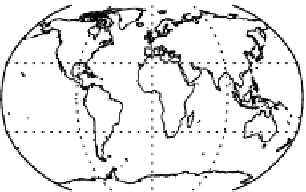Geoscience Reference
In-Depth Information
a
d
TOA Forcing (JJAS): Sinyuk
Surface Forcing (JJAS): Sinyuk
Glb. Avg. =
-
1.13 Wm
-2
Glb. Avg. =
-
0.39 Wm
-2
27
5
21
-5
15
9
-15
3
-25
-3
-9
-35
-15
-45
-21
-27
-55
Min = -25 ( 51.2E,27N)
Max = 7 ( 3.8W,19N)
Min = -35 ( 53.8E,25N)
Max = 0 ( 41.2W,79N)
b
e
TOA Forcing (JJAS): Patterson
Glb. Avg. =
0.39 Wm
-2
Surface Forcing (JJAS): Patterson
Glb. Avg. =
-
1.81 Wm
-2
27
5
21
-5
15
9
-15
3
-25
-3
-9
-35
-15
-45
-21
-27
-55
Min = -17 ( 51.2E,27N)
Max = 26 ( 3.8W,19N)
Min = -49 ( 53.8E,25N)
Max = 0 ( 41.2W,79N)
c
f
TOA Forcing (JJAS): 0.9x
ϖ
0
(Pat)
Surface Forcing (JJAS): 0.9x
ϖ
0
(Pat)
Glb. Avg. =
1.35 Wm
-2
Glb. Avg. =
-
2.68 Wm
-2
46
5
21
-5
15
9
-15
3
-25
-3
-9
-35
-15
-45
-21
-27
-68
Min = -9 ( 51.2E,27N)
Max = 46 ( 3.8W,19N)
Min = -68 ( 53.8E,25N)
Max = 0 ( 13.8W,75S)
Fig. 13.1
Forcing calculated at TOA and the surface during Northern Hemisphere (NH) summer
with the dust distribution prescribed from Miller et al. (
2006
). Shortwave absorption is prescribed
using (
a
,
d
) the compilation of Sinyuk et al. (
2003
), (
b
,
e
) Patterson et al. (
1977
), and (
c
,
f
)
Patterson et al. (
1977
) but with the particle single scattering albedo reduced by 10 %. The forcing
is calculated using the “double-call” method, and represents an average during the initial 5 years of
a simulation whose climate is perturbed by dust. Ocean temperature evolves according to a mixed-
layer model (Miller et al.
1983
). The forcing equals the contrast between radiative fluxes calculated
with and without dust. Note that extreme values of the color scale may vary among panels
versions documented by Schmidt et al. (
2006
,
2014
). Three different versions of the
forcing are calculated using distinct prescriptions of the particle optical properties.
The first prescription is taken from the compilation of shortwave absorption as a
function of wavelength by Sinyuk et al. (
2003
) that includes values retrieved by
Dubovik et al. (
2002
) and Colarco et al. (
2002
). The second is based upon
measurements of far-travelled Saharan dust (Patterson et al.
1977
). These two cases
probably bracket the global solar absorption. For the third case, we arbitrarily reduce
the single scattering albedo calculated from Patterson et al. (
1977
)by10%,which
roughly doubles the solar absorption. This third case is intended to emphasize the


























































































































































































































































































































































































































































































































































































































































































































































































































































































































































































































































































































































































Search WWH ::

Custom Search